Hospital discharges and length of stay statistics
Data extracted in October 2023.
Planned article update: December 2024.
Highlights
In 2021, France recorded the highest discharge rate for all hospitalised patients (41 100 per 100 000 inhabitants for in-patients and day care patients) among the EU Member States.
Circulatory diseases were the most common main diagnosis for in-patients in 2021 in most of the EU Member States; however, this was not the case in Ireland, Croatia or Romania.
In 2021, in-patients in Hungary and Czechia spent the longest average number of days in hospital, 9.7 and 9.5 days, respectively.
Average length of stay for hospital in-patients, 2021
This article presents an overview of European Union (EU) statistics related to the number and rate of hospital discharges and the average length of stay for patients in hospitals. It provides information relating to hospital discharges of in-patients and day care patients, providing analyses for the age and gender of patients and their diagnoses; this may be used as an indicator for the level of healthcare activity in hospitals. A similar collection of analyses is presented for the average length of stay for in-patients.
This article is one of a set of statistical articles concerning healthcare activities in the EU which forms part of an online publication on health statistics.
This article includes data that may have been impacted by the COVID-19 pandemic and its related restrictions. For this reason, particular attention should be paid when comparing the 2020 and/or 2021 data with data from earlier years.
In some EU Member States, healthcare resources were placed under intense pressure (particularly at the start of the pandemic) from an influx of patients with COVID-19. The pandemic also resulted in a range of knock-on effects including, among others, some services being curtailed/postponed due to the number of COVID-19 patients, staff shortages within hospitals and day care centres due to infection/quarantine procedures, and patients being hindered access to medical services due to their own infection/quarantine as well as lockdown or travel restrictions.
Full article
Hospital discharges
A hospital discharge occurs when a hospital patient is formally released after an episode of care. The reasons for discharge include finalisation of treatment, signing out against medical advice, transfer to another healthcare institution, or because of death. The data should cover all types of hospitals, including general hospitals, mental health hospitals and other specialised hospitals, as well as all types of diagnosis and treatment, including discharges of healthy new-borns.
In practice, data availability is more limited in some national statistics and a summary of the main deviations from the standard coverage is provided in the Data sources section below. In cases where national statistics exclude any types of hospitals this will understate, to a greater or lesser extent, the number and rate of discharges. This is particularly true for certain types of diagnoses if the exclusions are related to specialisations. For example, the exclusion of psychiatric hospitals or mental health care institutions has an impact on the data for discharges of patients diagnosed with mental and behavioural disorders.
Cyprus, Ireland, France, Romania, Portugal, Spain and the Netherlands reported more day care patients than in-patients
Among the 20 EU Member States for which recent data are available for in-patients and for day care patients (incomplete data for Belgium, Bulgaria, Denmark, Greece, Croatia, Luxembourg and Malta), Cyprus, Ireland, France, Romania, Portugal, Spain and the Netherlands reported more discharges of day care patients than in-patients in 2021. By contrast, there were around 10 times as many in-patient discharges as discharges of day care patients in Sweden, and this ratio reached a level between 25 and 43 times as high in Czechia, Slovakia and Germany.
Relative to population size, discharge rates in 2021 for in-patients were in the range of 11 900 to 16 500 per 100 000 inhabitants for most EU Member States (see Figure 1).
- Austria, Germany and most notably Bulgaria (29 300 per 100 000 inhabitants) reported higher rates.
- Cyprus, Spain, Italy, the Netherlands and Portugal, reported lower rates.
Comparing the highest and lowest values, the in-patient discharge rate in Bulgaria was 3.8 times as high as in Portugal.
Figure 1 compares the in-patients discharge rate for 2021 with the rate for 2020, in other words comparing the second and first calendar years of the outbreak of the COVID-19 pandemic; note that the COVID-19 crisis may have impacted discharge numbers in 2020 and 2021. A majority (16 from 21) of the EU Member States for which data are available recorded a higher discharge rate in 2021. Germany, Estonia, Czechia, Slovakia and Hungary reported lower rates in 2021. Among the non-EU countries for which data are presented in Figure 1, Liechtenstein was the only one to record a rate in 2021 that was below its 2020 value.
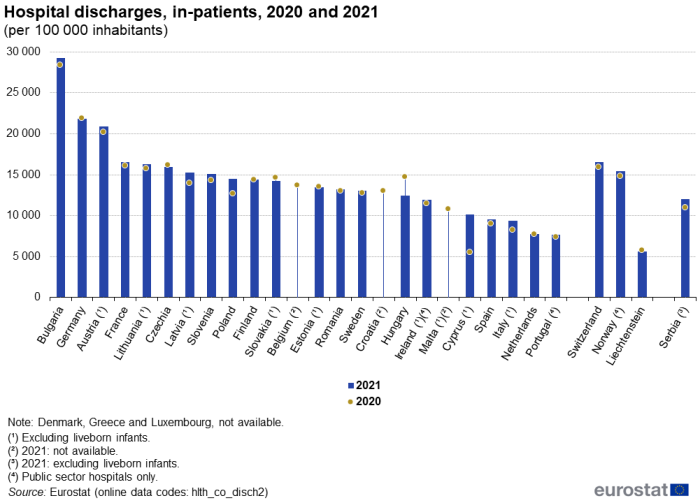
(per 100 000 inhabitants)
Source: Eurostat (hlth_co_disch2)
Turning to discharges of day care patients relative to population size (see Figure 2), the discharge rates among the EU Member States in 2021 were generally in the range of 1 300 to 15 900 per 100 000 inhabitants.
- Ireland, Croatia, France and Cyprus reported rates that were higher (20 400 to 25 600 per 100 000 inhabitants).
- Czechia (640 per 100 000 inhabitants), Germany (502 per 100 000 inhabitants) and Slovakia (338 per 100 000 inhabitants) reported lower rates.
In 14 of the 23 EU Member States for which data are available for the 2 years shown in Figure 2, the ratio of day care discharges to population size increased over a 10-year period; note that the COVID-19 crisis may have impacted day care discharge numbers in 2021. In absolute terms, the largest increases in this rate were observed in Cyprus (note that there is a break in series), Croatia, France and Romania, up by at least 10 000 discharges per 100 000 inhabitants. The largest decrease was in the Netherlands, down 5 600 discharges per 100 000 inhabitants.

(per 100 000 inhabitants)
Source: Eurostat (hlth_co_disch4)
The highest discharge rate for all hospitalised patients was in France
Combining discharge rates in 2021 for in-patients and day care patients, the highest discharge rate for all hospitalised patients was in France with a rate of 41 100 per 100 000 inhabitants (incomplete data for Belgium, Bulgaria, Croatia and Malta; no recent data for Denmark, Greece or Luxembourg). Cyprus and Ireland also reported rates above 30 000 per 100 000 inhabitants, with Bulgaria (excluding day care patients) and Romania recording rates just below this level. The lowest combined rate was in Italy (11 900 per 100 000 inhabitants).
Hospital discharges by sex and age
Fewer discharges of male patients than of female patients in nearly all EU Member States
Among the EU Member States for which data are available (no recent data for Denmark, Greece or Luxembourg), in all but one – Malta (2020 data) – there were more discharges of female in-patients than male in-patients in 2021. This was also the case in most of the non-EU countries shown in Figure 3, Montenegro (2019 data) being the only exception. For day care patients (no recent data also for Bulgaria and Estonia), Cyprus (2019 data), France, Germany, Ireland and Malta (2020 data) reported more discharges of male patients than female patients.

(ratio)
Source: Eurostat (hlth_co_disch1) and (hlth_co_disch3)
Tables 1 and 2 provide an analysis of discharge rates in 2021 by age, distinguishing male and female patients, as well as in-patients and day care patients. Due to space constraints, only a selection of age ranges is shown, whereas the full set of data – available online – has been used for the following commentary.
Different age pattern to in-patient discharge rates for males and females, mainly characterised by high discharge rates for females in typical child-bearing age ranges
Among male in-patients, discharge rates were generally high for infants aged less than 1 year, then fell to relatively low rates among males aged 5–29 years, before increasing again in old(er) age. Among female in-patients, discharge rates:
- were also generally high for female infants aged less than 1 year;
- fell to relatively low rates among female children aged 5–14 years;
- increased through common childbearing ages to a peak in the age groups around 30–34 years;
- decreased again to another low among females aged 40–44 or 45–49 years (but at higher rates than the low observed for female children);
- increased again in old(er) age, although with discharge rates that were generally lower than for males.
Discharge rates for infants aged less than 1 year exceeded 125 000 per 100 000 inhabitants in Belgium (2020 data), France and Slovenia for both males and females. In Switzerland, this rate was also above 125 000 per 100 000 inhabitants for males. Among the EU Member States, the lowest discharge rates for infants aged less than 1 year, below 25 000 per 100 000 inhabitants, were recorded in Cyprus for males and for females. In Serbia, this rate was also below 25 000 per 100 000 inhabitants for females. Note that the data for several EU Mpember States and for Serbia do not include discharges of healthy new-borns.
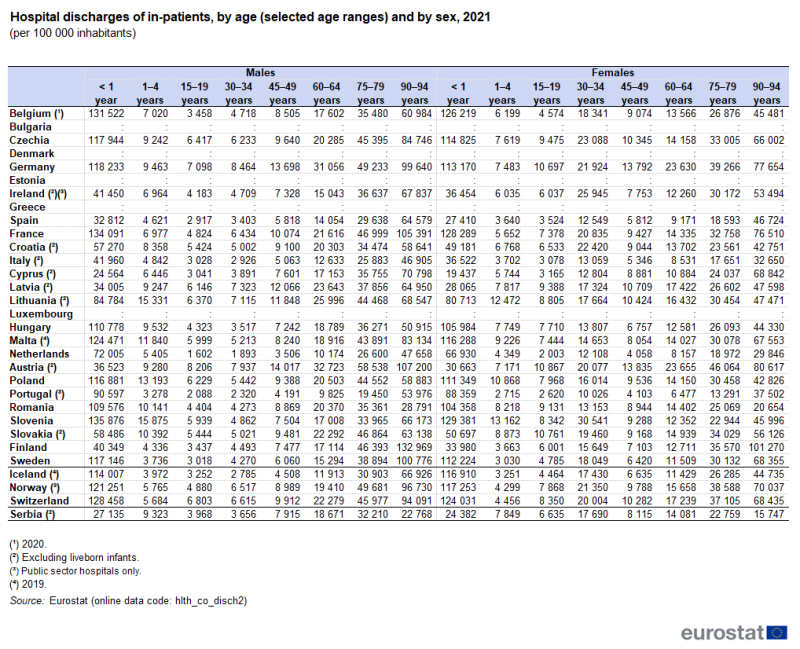
(per 100 000 inhabitants)
Source: Eurostat (hlth_co_disch2)
The age structure of discharge rates for day care patients is quite similar for males and females
While for in-patients the highest discharge rates were normally recorded for infants aged less than 1 year, for day care patients this was only the case in Germany, Slovakia and Sweden (no recent data or incomplete data for Bulgaria, Denmark, Estonia, Greece and Luxembourg). In fact, some EU Member States recorded their lowest discharge rates for day care patients among infants aged less than 1 year: Hungary just for males and France for males and females.
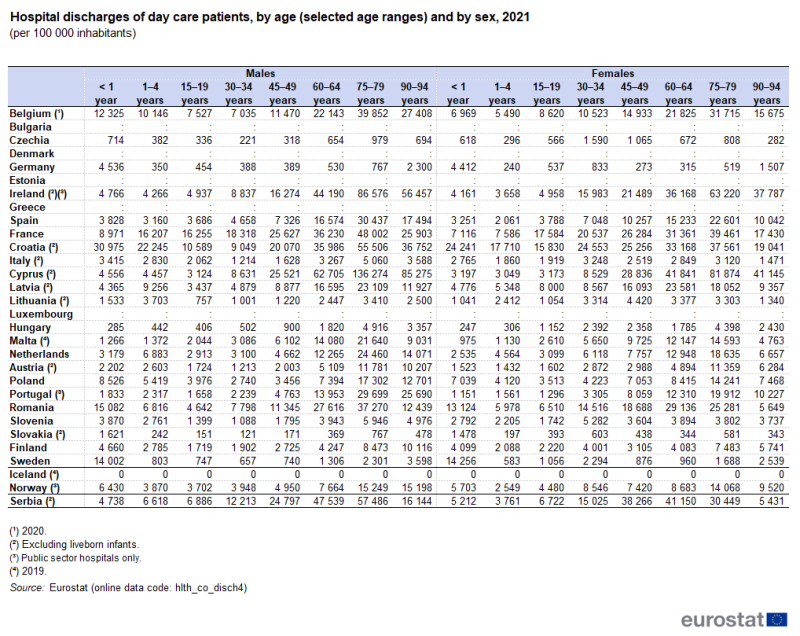
(per 100 000 inhabitants)
Source: Eurostat (hlth_co_disch4)
In 2021, day care discharge rates for males in many EU Member States fell across the age groups from relatively high rates for infants aged less than 1 year through to relatively low rates for age groups between 5–9 and 30–34 years. The rates were generally higher for older age groups and often peaked in the age groups around 70–74 through to 80–84 years before declining again. There were only a few exceptions to these patterns for the lowest and highest rates for males:
- in Slovakia, the lowest rate was among people aged 95 years or over, and this was also the case in Serbia; as noted above, the lowest rate for males in France and Hungary was for infants aged less than 1 year;
- in Lithuania, the age group with the highest discharge rate for males was for children aged 1–4 years; as noted above, the highest rate for males in Germany, Slovakia and Sweden was for infants aged less than 1 year.
For females, the general pattern was somewhat different. The lowest day care discharge rates for females in 2021 were most often recorded in younger age groups than for males, particularly for children aged 5–9 years and 10–14 years. Atypically, the lowest rates were recorded in Poland for the age group (20–24 years) and in Italy, Lithuania and Romania (as well as in Serbia) for the age group 95 years and over; as noted above, the lowest rate for females in France was for infants aged less than 1 year.
It was common among the EU Member States for day care discharge rates for females to rise again from the age group 15–19 years. In line with what was observed for males, day care discharge rates in 2021 for females most commonly peaked for the age group 75–79 years (or in a slightly younger or older age group) before dipping back down for the oldest age groups. A small number of Member States recorded their highest day care discharge rates for females among younger age groups:
- for the age group 50–54 years in Lithuania;
- for the age groups 30–34 years or 35–39 years in Czechia, Italy and Slovenia;
- for infants aged less than 1 year in Germany, Slovakia and Sweden (as noted above).
Hospital discharges by diagnosis
Discharges by diagnosis – as presented in Tables 3 and 4 as well as Figure 4 – refer to the principal diagnosis, in other words, the main condition diagnosed at the end of a patient's hospitalisation. The main condition is the one primarily responsible for the patient's need for treatment or investigation.
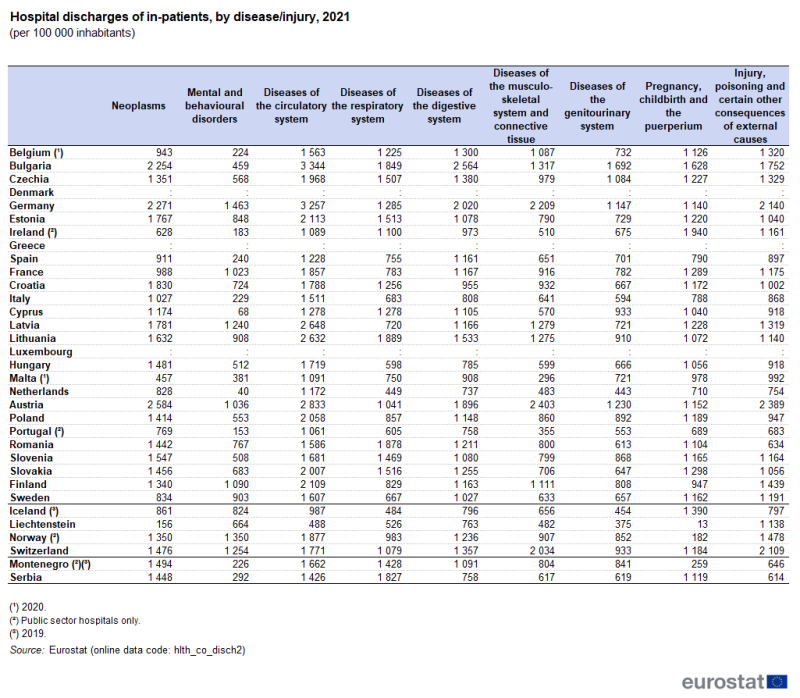
(per 100 000 inhabitants)
Source: Eurostat (hlth_co_disch2)
In nearly all EU Member States, circulatory diseases were the most common main diagnosis for in-patients
For in-patients, the main diagnosis in 2021 across EU Member States was circulatory diseases, as shown in Table 3 and Figure 4. The rare exceptions to this were: Ireland where the category of pregnancy and childbirth was the most common; Romania where diseases of the respiratory system were the most common; Croatia where neoplasms (benign or malignant cancers) were the most common. In two of these three Member States, circulatory diseases were the second most common diagnosis, whereas in Ireland the category of injury, poisoning and certain other consequences of external causes was the second most common. Across all of the Member States, other diagnoses that were also common included neoplasms, diseases of the digestive system, injury, poisoning and certain other consequences of external causes, pregnancy and childbirth, and diseases of the respiratory system.

(per 100 000 inhabitants)
Source: Eurostat (hlth_co_disch2)
The most common main diagnoses for day care patients were neoplasms and diseases of the digestive or genitourinary systems
For day care patients, the most common main diagnosis was less clear cut in 2021, with a majority of the EU Member States reporting their highest discharge rates for either neoplasms or for diseases of the genitourinary system, reflecting the use of day care for some cancer treatments (such as chemotherapy) and some kidney disease treatments (such as dialysis). There were four other diagnoses that were relatively common across the Member States:
- diseases of the digestive system, which was the most common in Belgium (2020 data), Ireland, Spain and Malta (2020 data);
- diseases of the musculo-skeletal system and connective tissue, which was the most common in Latvia;
- mental and behavioural disorders, which was the most common in France; and
- diseases of the circulatory system, which was the most common in Germany.
Although less common in general among the EU Member States, injury, poisoning and certain other consequences of external causes was the most common diagnosis for day care patients in 2021 in Finland and Sweden.
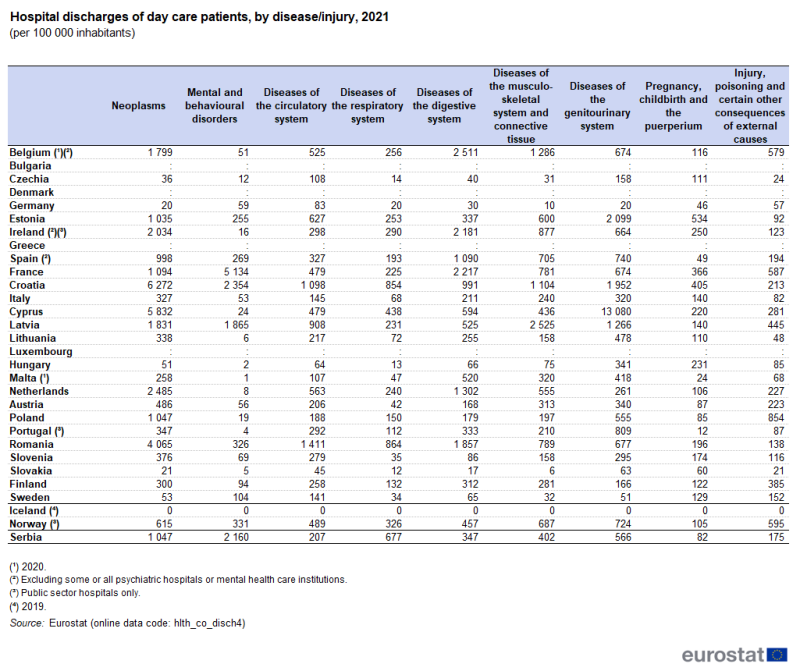
(per 100 000 inhabitants)
Source: Eurostat (hlth_co_disch4)
Average length of hospital stay for in-patients
The average length of stay for in-patients is calculated from the total number of nights spent in hospitals divided by the total number of discharges. As such, the average length of stay may be less influenced by coverage issues (insofar as the average length of stay in the institutions excluded from the coverage may be similar to that in the institutions that are covered). This is clearly not the case when only acute care institutions are covered but not those providing long-term care; in these cases, the average length of stay is likely to be underestimated. A summary of the main deviations from the standard coverage is provided in the Data sources section below and highlights those national statistics where some of these issues can be found.
In 2021 (or the latest year for which data are available; see Figure 5), the average length of a hospital stay for in-patients ranged in most EU Member States from 5.1 days in Cyprus to 8.8 days in Germany. The Netherlands was below this range (4.3 days) while Czechia (9.5 days) and Hungary (9.7 days) were above it. Among the non-member countries for which data are available, Serbia reported a relatively high average (10.9 days).
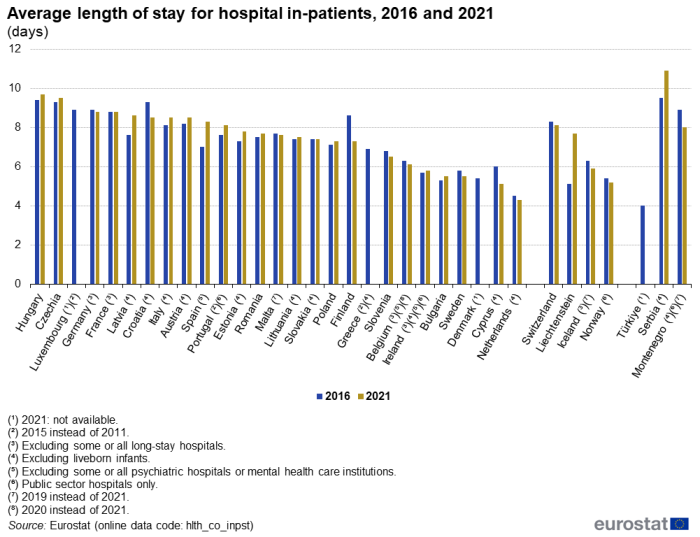
(days)
Source: Eurostat (hlth_co_inpst)
Comparing the average length of stay in 2021 (or latest year) with the situation in 2016, around a third of the EU Member States – 9 out of 24 (incomplete data for Denmark, Greece and Luxembourg) – observed a decrease in the average length of days spent in hospital by in-patients. The largest decrease was in Finland, where the average fell from 8.6 days to 7.3 days between 2016 and 2021. By contrast, 13 Member States recorded an increase during this period. The largest increases were in Latvia (up from 7.6 to 8.6 days) and Spain (up from 7.0 to 8.3 days). Consequently, there were two Member States where there was no change in the average length of stay for hospital in-patients: France and Slovakia.
Males generally spent longer than females in hospital
Although there were generally more female in-patients than male in-patients (see Figure 3), in most of the EU Member States the average length of stay for male in-patients in 2021 was generally longer than for females. The main exception to this pattern, as can be seen from Figure 6, was Hungary, although there was also a slightly longer average stay for females in Belgium. By contrast, in 12 Member States the average length of stay was at least 1.0 days longer for males than for females; the largest difference was in Croatia (2020 data), where males stayed 1.6 days longer on average.
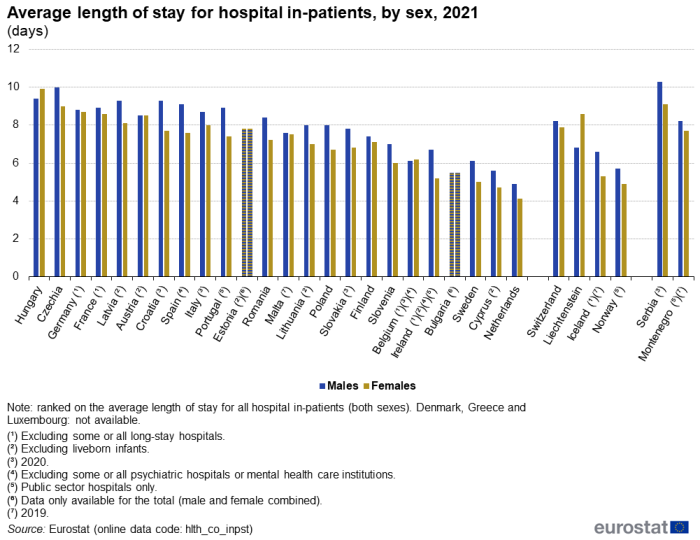
(days)
Source: Eurostat (hlth_co_inpst)
The average length of in-patient stays tended to be shortest for children aged 1–9 years and highest for people aged 85 years or over
A detailed age group analysis of the average length of in-patient hospital stays in 2021 is presented in Table 5.
- The average length of stay was generally lower for young children aged 1–4 years and 5–9 years than it was for the youngest age group, in other words infants aged less than 1 year. Czechia, Germany, Italy (2020 data), Lithuania and Portugal were exceptions among the EU Member States, as was Iceland (2019 data) among non-EU countries.
- Between the age groups 5–9 years and 10–14 years there was an increase in the average length of stay in all Member States. The average then remained relatively stable through to the age group 30–34 years.
- Thereafter, the average length of in-patient stays generally increased through each age group: in 18 of the 22 Member States for which data are available, it peaked in one of the three oldest age groups.
There were four EU Member States where the longest average length of stay was not among older people. In Cyprus (2018 data) and Sweden, the longest average stays were recorded among the youngest age group (children aged less than 1 year). In Germany and Croatia (2020 data), the longest average length of stay was recorded for the age group 55–59 years. Among the non-member countries included in the table, Norway was also an exception to the general rule, with its longest average length of stay among people aged 20–24 years.
Austria had the biggest difference in average length of stay between the age groups, with an average of 3.3 days for children aged 1–4 years rising up to an average of 20.1 days for people aged 95 years or over, a gap of 16.8 days. Large gaps in the average length of stays by age were also observed in Hungary, Czechia and Malta (2019 data).
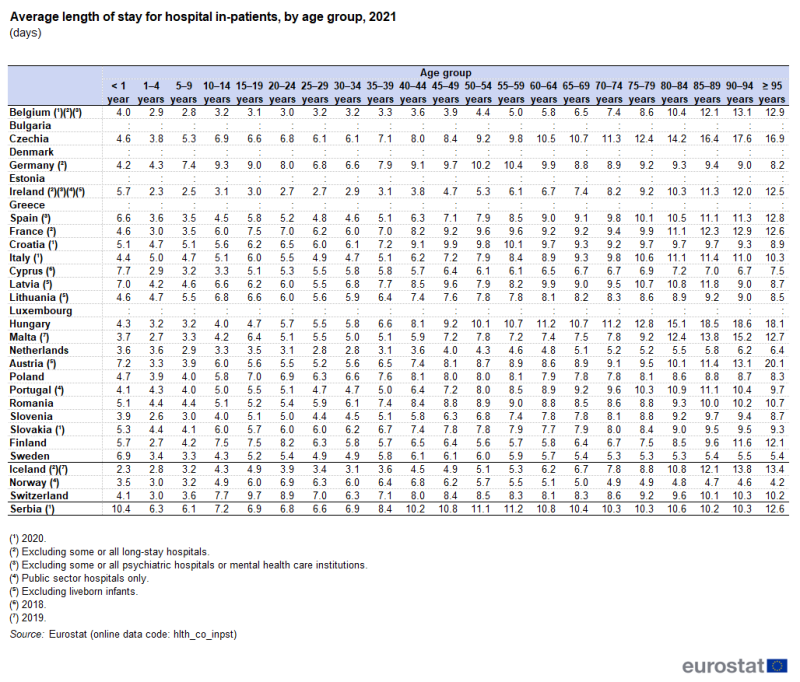
(days)
Source: Eurostat (hlth_co_inpst)
In-patients with mental and behavioural disorders generally spent the longest time in hospital per stay
Among the nine diagnoses presented in Table 6, the average length of stay for in-patients in 2021 was notably longer for mental and behavioural disorders. Note that in several EU Member States, the data presented in Table 6 exclude discharges from some or all psychiatric hospitals or mental health care institutions. The longest average stays for in-patients with mental and behavioural disorders were reported for Spain and Czechia, where the average stays were 53.1 and 43.4 days, respectively. Among the other diagnoses, average stays were generally longest for patients being diagnosed or receiving treatment for: diseases of the respiratory system; diseases of the circulatory system; injury, poisoning and certain other consequences of external causes; or neoplasms.
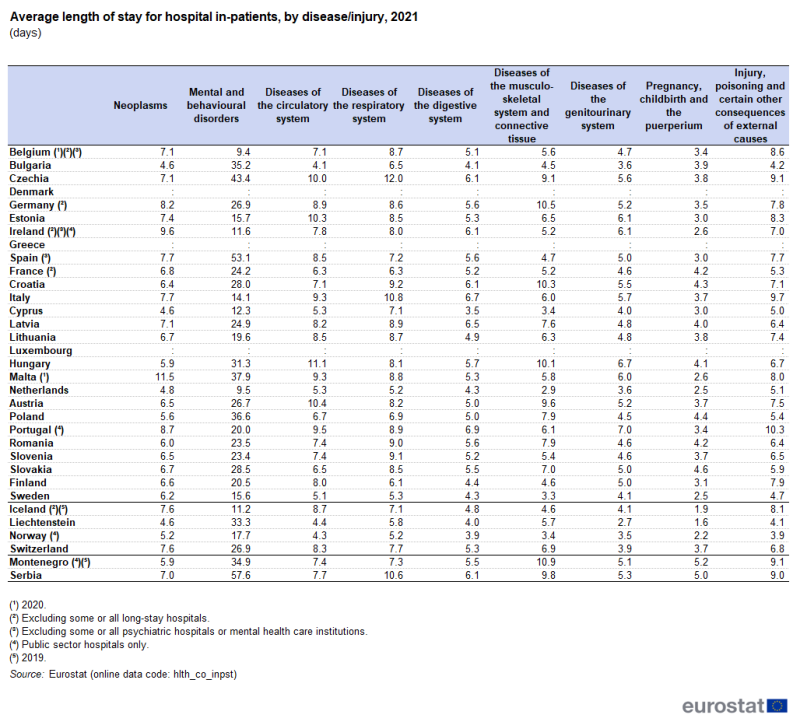
(days)
Source: Eurostat (hlth_co_inpst)
For several of the diagnoses shown in Table 6 there was a relatively high degree of uniformity in the average length of stay in 2021 reported by each EU Member State. For example, in-patients diagnosed with diseases of the digestive system spent, on average, between 3.5 days (in Cyprus) and 6.9 days (in Portugal) in hospital; patients diagnosed with diseases of the genitourinary system and those in hospital for pregnancy, childbirth and the puerperium, also had a relatively narrow range in the average lengths of stay across the Member States.
For injury, poisoning and certain other consequences of external causes, as well as for diseases of the respiratory system, neoplasms, diseases of the circulatory system, and diseases of the musculo-skeletal system and connective tissue, the average length of stay for in-patients in 2021 was somewhat more diverse. The range between the shortest and longest average stays across the EU Member States was between 6 and 8 days.
For mental and behavioural disorders, the average length of stay varied even more, although this is influenced to some extent by the fact that the length of stay of patients in some or all psychiatric hospitals or mental health care institutions are excluded in several Member States. The shortest average stay was 9.4 days as recorded in Belgium (2020 data) while the longest in 2021, as noted above, was 53.1 days in Spain, a difference of 43.7 days.
Source data for tables and graphs
Data sources
Key concepts
An in-patient is a patient who is formally admitted (or 'hospitalised') to an institution for diagnosis, treatment and/or care and stays for a minimum of one night or more than 24 hours in the hospital or other institution providing in-patient care. In contrast to in-patient care, the intention for day care is to discharge the patient on the same day as admitted. Day care comprises planned medical and paramedical services delivered to patients who have been formally admitted for diagnosis, treatment or other types of health care.
An in-patient or day care patient is discharged from hospital when formally released after a procedure or course of treatment (episode of care). A discharge may occur because of the finalisation of treatment, signing out against medical advice, transfer to another healthcare institution, or because of death.
The average length of stay of in-patients in hospitals is computed by first calculating the number of hospital days (or bed-days or in-patient days) from the date of admission to an in-patient institution as the date of discharge minus date of admission, and then dividing this by the number of discharges during the year.
Healthcare resources and activities
Statistics on healthcare activities such as information on discharges and average length of stay are documented in this background article which provides information on the scope of the data, its legal basis, the methodology employed, as well as related concepts and definitions.
The Healthcare non-expenditure statistics manual provides an overview of the classifications, both for mandatory variables and variables provided on voluntary basis.
The main diagnosis for discharges is based on the International Statistical Classification of Diseases and Related Health Problems (ICD-10). The diagnoses presented in this article include the following.
- C00–D48 Neoplasms
- F00–F99 Mental and behavioural disorders
- I00–I99 Diseases of the circulatory system
- J00–J99 Diseases of the respiratory system
- K00–K93 Diseases of the digestive system
- M00–M99 Diseases of the musculo-skeletal system and connective tissue
- N00–N99 Diseases of the genitourinary system
- O00–O99 Pregnancy, childbirth and the puerperium
- S00–T98 Injury, poisoning and certain other consequences of external causes
For country specific notes on the collection of healthcare non-expenditure statistics, please refer to the annexes at the end of the national metadata reports accessible from links at the beginning of the European metadata report. Data do not always cover all hospitals, treatments or types of patients. The main exceptions noted for 2021 data (or the latest available year when 2021 data are not available) by EU Member States and non-EU countries are listed below.
| Types of institutions | Main exception(s) |
|---|---|
| Belgium | Excludes long-stay hospitals (covers only acute care hospitals) and psychiatric/mental health hospitals |
| Germany | Excludes prevention and rehabilitation facilities with 100 or fewer beds |
| Ireland | Excludes private hospitals, long-stay hospitals (covers only acute care hospitals) and psychiatric/mental health hospitals |
| Spain | Day cases: excludes psychiatric and long-stay hospitals unless they form a hospital complex |
| France | Excludes long-term care hospitals |
| Croatia | Excludes prison hospitals |
| Italy and Poland | Excludes military hospitals |
| Lithuania and Romania | Excludes hospitals that do not have a contract with the national health insurance fund |
| The Netherlands | Excludes private and semi-private hospitals, the military hospital, mental health and substance abuse hospitals, epilepsy clinics and long-stay hospitals (covers only acute care hospitals) |
| Portugal, Norway and Montenegro | Excludes private hospitals |
| Slovenia | Excludes rehabilitative care in specialised centres |
| Iceland | Excludes specialised institutions such as rehabilitation centres, nursing homes or residential care facilities |
| Switzerland | Excludes prison and military hospitals |
| Serbia | Excludes prison hospitals and military hospitals as well as some private hospitals |
| Types of activity / treatment | Main exception(s) |
| The Netherlands | Excludes part-time psychiatric treatments in general or university hospitals with a psychiatric ward; rehabilitation day-treatment; day care admissions for normal deliveries of babies |
| Types of patient | Main exception(s) |
| Belgium (184 days), Italy (365 days), Lithuania (120 days for nursing hospitals) and Slovakia (700 days) | Excludes long-term patients |
| France and Luxembourg | Excludes non-residents |
Symbols
Tables in this article use the following notation
Value is : for not available.
Context
Statistics on hospital discharges and the average length of hospital stays reflect the balance between the demand for and supply of hospital services. They represent how many patients were actually admitted (as in-patients or day care patients) and how long they were treated; they can be complemented by other supply side statistics such as occupancy rates (see an article on hospital beds), the frequency of operations and procedures, healthcare expenditure, as well as demand side statistics (see an article on unmet medical needs).
The balance between in-patient and day care patient discharges, as well as the number of out-patients and the average length of hospital stays, reflect a number of factors:
- demographic changes such as an ageing population which pushes up demand for hospital services;
- budgetary pressures to keep costs down; and
- changes in practices and technology impacting on the length of acute care and/or the balance between in-patient care, day care and out-patient care.
The European core health indicators (ECHI) shortlist includes indicators on hospital in-patient discharges, hospital day cases and average length of stay in the chapter on health services.
Direct access to
Online publications
Healthcare activities and expenditure
- Beds
- Consultations
- Healthcare expenditure
- Surgical operations and procedures
- Unmet needs for health care
Methodology
General health statistics articles
- Health (t_hlth)
- Health care (t_hlth_care)
- Discharges from hospitals (tps00048)
- Health care (t_hlth_care)
- Health (hlth)
- Health care (hlth_care)
- Health care activities (hlth_act)
- Hospital discharges and length of stay for in-patient curative care (hlth_co_inpagg)
- Hospital discharges - national data (hlth_hosd)
- Hospital discharges by diagnosis, in-patients, total number (hlth_co_disch1)
- Hospital discharges by diagnosis, in-patients, per 100 000 inhabitants (hlth_co_disch2)
- Hospital discharges by diagnosis, day cases, total number (hlth_co_disch3)
- Hospital discharges by diagnosis, day cases, per 100 000 inhabitants (hlth_co_disch4)
- Length of stay in hospital (hlth_hostay)
- In-patient average length of stay (days) (hlth_co_inpst)
- Health care activities (hlth_act)
- Health care (hlth_care)
Manuals and guidelines
Metadata
- Healthcare non-expenditure statistics (ESMS metadata file – hlth_res_esms)